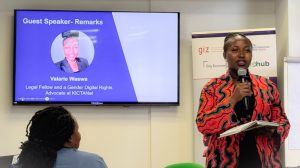By Nicodemus Nyakundi
Online disinformation is propagated by simply clicking on the share button. The intent is to mislead and daint the image and reputation of the victim.
Its target is to spread and reach a vast majority of the targeted audience. Although it spreads quickly, it can also be stopped by simple techniques like STICK ( Stop Think – Check!).
It is worth noting that disinformation also slims the thin fine line between freedom of expression and censorship. It offsets the balance between right and wrong, calling for stringent and executable guidelines and policies that separate information from dis/misinformation.
Significant concerns are on how disinformation manifests and at what point its intersection and censorship occur. As a KICTANet fellow, Nicodemus Nyakundi highlighted in a session on the intersection of disinformation and other online harms at the IGF2022 that has led to an increase in intersectionality barring the efforts made in fighting Online Gender-Based Violence (OGBV).
The vices that the Gender Program from KICTANet has been fighting after realizing the plight and violence directed at Kenyan women in politics.
It’s a fact that disinformation usually has a gendered element, is intentional, and has an ill motive. It is generally coupled with threats to safety and harm to psychological integrity. And this, especially for politicians, is a big task given that they have to fight through several other layers to get elected.
Laws and policy guidelines can protect us against online harms and threats like disinformation. This also calls for a collective effort from all stakeholders. If we try to combat this malice and individually take full responsibility for fact-checking any form of information, then we can slay this beast of online-based violence.
____________________________________________________________
Nicodemus Nyakundi is an ICT Access and Equality Fellow for PwDs at KICTANet. He has a background in Information Technology.
![]()




